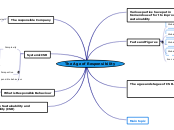The Age of Responsibility
Main topic
The ages and stages of CSR.
Dr Wayne Visser is Founder and Director of the think-tank CSR International and the author /editor of twelve books, including nine on the role of business in society, such as The A to Z of Corporate Social Responsibility and The World Guide to CSR.
Age of Responsibility
Comprehensive responsibility towards sustainability
Systemic
Systemic CSR in the Age of Responsibility focuses its activities on identifying and tackling the root causes of our present unsustainability and irresponsibility, typically through innovating business models, revolutionizing their processes, products and services and lobbying for progressive national and international policies.
Systemic CSR focuses on understanding the interconnections of the macro level system – society and ecosystems – and changing its strategy to optimize the outcomes for this larger human and ecological system.
Visser, Wayne (2011-03-08). The Age of Responsibility: CSR 2.0 and the New DNA of Business (p. 20). Wiley Publishing. Kindle Edition.
Regulators and customers
Age of Management
Strategic CSR, emerging from the Age of Management, means relating CSR activities to the company’s core business (like Coca-Cola’s focus on water management), often through adherence to CSR codes and implementation of social and environmental management systems, which typically involve cycles of CSR policy development, goal and target setting, programme implementation, auditing and reporting.
Strategic
shareholders, NGOs and CSOs
Age of Marketing
Promotional CSR in the Age of Marketing is what happens when corporate sustainability and responsibility is seen mainly as a public relations opportunity to enhance the brand, image and reputation of the company. Promotional CSR may draw on the practices of Charitable and Strategic CSR and turn them into PR spin, which is often characterized as ‘greenwash’.
Promotional
General Public
Age of Philanthropy
Charitable CSR in the Age of Philanthropy is where a company supports various social and environmental causes through donations and sponsorships, typically administered through a Foundation, Trust or Chairman’s Fund and aimed at empowering community groups or civil society organizations (CSOs).
Charitable
Communities
Age of Greed
The Age of Greed is characterized by Defensive CSR in which all corporate sustainability and responsibility practices – which are typically limited – are undertaken only if and when it can be shown
that shareholder value will be protected as a result. Hence, employee volunteer programmes (which show evidence of improved staff motivation, commitment and productivity) are common, nor are targeted expenditures (for example, on pollution controls) which are seen to fend off regulation or avoid fines and penalties.
Defensive
Shareholders, government and employees
Facts and Figures
Are companies more of the problem or solution?
Global Dishonesty
According to another of Transparency International’s indexes – the 2008 Bribe Payers Index (BPI) – companies based in the emerging economic giants are perceived to routinely engage in bribery when doing business abroad. For example, Russia ranked last with a score of 5.9 (where 10 represents no corruption), just below China (6.5), Mexico (6.6) and India (6.8). At the other end of the spectrum, Belgium and Canada shared first place with a score of 8.8, while the Netherlands and Switzerland shared third place on the index with 8.7. Transparency International estimates that bribery, cartels and other corrupt practices undermine competition and contribute to a massive loss of resources for development in all countries, especially the poorest ones. For example, between 1990 and 2005, more than 283 private international cartels that cost consumers around the world an estimated $300 billion in overcharges were exposed.
Visser, Wayne (2011-03-08). The Age of Responsibility: CSR 2.0 and the New DNA of Business (pp. 15-16). Wiley Publishing. Kindle Edition.
Global Village
The 2010 UN Millennium Development Goals (MDGs) report shows that the number of people in developing regions living on less than $1.25 a day reduced from 1.8 billion in 1990 to 1.4 billion in 2005, while the overall poverty rate dropped from 46% to 27%.
Other areas of progress have been major advances in getting children into school in many of the poorest countries, especially in sub-Saharan Africa. There have also been remarkable improvements in key interventions. For example, for malaria and HIV control and measles immunization, the number of child deaths has been cut from 12.5 million in 1990 to 8.8 million in 2008.
Despite this remarkable progress, however, huge challenges remain.
Disparities between rural and urban areas are daunting, with only 40% of rural populations covered. The gaps between rich and poor are equally stark: while 77% of the population in the richest 20% of households have acquired improved sanitation facilities, only 16% of those in the poorest households have had similar improvements. Disparities in access to care during pregnancy are also striking, with women in the richest households 1.7 times more likely than the poorest women to visit a skilled health worker at least once before birth.
Underscoring the inequality that we still face in the world, Gallup’s 2010 global snapshot of wellbeing revealed that the percentage of people who are ‘thriving’ ranges from a high of 82% in Denmark to a low of 1% in Togo. Africa has the lowest wellbeing, with no country in this region showing a thriving indicator higher than 25%. In fact, of the 41 countries where thriving is 10% or lower, more than half are in Africa. Elsewhere in the world, however, disparities also exist. Thriving in the Americas is highest in Costa Rica (63%) and Canada (62%) and lowest in Cuba (24%) and Haiti (4%). In Europe, self-reported wellbeing is lowest in Bulgaria (6%) and highest in Denmark (82%) and Finland (75%). Similar disparities are evident in Asia. ‘Thriving’ is 60% or higher in New Zealand (63%), Israel (62%), and Australia (62%) and 10% or lower in 11 nations, with Cambodia at the bottom with 3%.
Floating Topic
Global weather
The 2006 Stern Review on The Economics of Climate Change concludes that climate change is ‘the greatest market failure the world has ever seen’ and estimates that the cost of action to reduce GHGs and avoid the worst impacts of climate change can be limited to about 1% of global GDP per year if action is immediate and decisive. By contrast, failure to act swiftly will damage economic growth. Specifically, inaction will result in a persistent annual loss of 5% of global GDP. If a wider range of impacts and risks is considered, this could be as high as 20% of GDP, or more. It is important to emphasize that climate change is not just an environmental issue. A 2009 UNDP report estimates significant impacts of global warming on the world’s 2.6 billion people surviving on less than $2 a day, including up to 600 million more people facing malnutrition due to the breakdown of agricultural systems resulting from increased exposure to drought, rising temperatures and more erratic rainfall. The report estimates potential productivity losses of 26% by 2060 in semi-arid areas of sub-Saharan Africa, home to some of the highest concentrations of poverty in the world. An additional 1.8 billion people are expected to experience water stress by 2080, with large areas of South Asia and northern China facing a grave ecological crisis as a result of glacial retreat and changing rainfall patterns. In addition, up to 332 million people in coastal and low-lying areas may be displaced by flooding and tropical storm activity, including more than 70 million Bangladeshis, 22 million Vietnamese, and six million Egyptians. Finally, related health effects suggest that as many as 400 million people are likely to face the risk of malaria as a result of climate change. National Geographic have also identified dengue fever as a major risk.
Visser, Wayne (2011-03-08). The Age of Responsibility: CSR 2.0 and the New DNA of Business (p. 12). Wiley Publishing. Kindle Edition.
Visser, Wayne (2011-03-08). The Age of Responsibility: CSR 2.0 and the New DNA of Business (p. 12). Wiley Publishing. Kindle Edition.
Global footprint
environmental impacts. According to the Global Footprint Network, humanity’s ecological footprint, driven by the spread of capitalism and Western lifestyles globally, has more than tripled since 1961. Since the late 1980s, we have been in ‘overshoot’ – meaning that the world’s ecological footprint has exceeded the earth’s biocapacity. An ecological footprint analysis shows that while global biocapacity – the area available to produce our resources and capture our emissions – is 2.1 global hectares (ha) per person, the per person footprint is already 2.7 global ha.
Visser, Wayne (2011-03-08). The Age of Responsibility: CSR 2.0 and the New DNA of Business (p. 9). Wiley Publishing. Kindle Edition. The USA and China have the largest national footprints, each in total about 21% of global biocapacity, but US citizens each require an average of 9.4 global ha (or nearly 4.5 Planet Earths if the global population had US consumption patterns), while Chinese citizens use on average 2.1 global ha per person (one Planet Earth). Biocapacity is also unevenly distributed, with eight nations – the United States, Brazil, Russia, China, India, Canada, Argentina and Australia – containing more than half the world total.
Visser, Wayne (2011-03-08). The Age of Responsibility: CSR 2.0 and the New DNA of Business (p. 9). Wiley Publishing. Kindle Edition. UN Millennium Ecosystem Assessment, issued in 2005, which reaches similar conclusions: 60% of world ecosystem services have been degraded; of 24 evaluated ecosystems, 15 are being damaged; water withdrawals have doubled over the past 40 years; and over a quarter of all fish stocks are over-harvested. Since 1980, about 35% of mangroves have been lost; around 20% of corals have been lost in just 20 years and 20% more have been degraded; and species extinction rates are now 100 – 1,000 times above the background (‘natural’) rate. So, by all accounts, capitalism is failing spectacularly to control the environmental impacts of the economic activities that it is so successful at stimulating. What many people fail to appreciate is how uneconomic this environmental destruction really is. For example, a 2010 study conducted for the UN by Trucost found the estimated combined damage of the world’s 3,000 biggest companies was worth $2.2 trillion in 2008 – a figure bigger than the national economies of all but seven countries in the world that year, and equal to one-third of the average profits of those companies. In 2010, The Economics of Ecosystems and Biodiversity (TEEB) study also found that degradation of the Earth’s ecosystems and biodiversity due to deforestation alone costs us natural capital worth somewhere between $1.9 and $4.5 trillion every year.
Visser, Wayne (2011-03-08). The Age of Responsibility: CSR 2.0 and the New DNA of Business (p. 10). Wiley Publishing. Kindle Edition.
EarthOvershootDay_2014_PR_General.pdf
Corporate Sustainability and responsibility (CSR)
Responsible Behaviour of companies
Various parties have put in tremendous effort to improve sustainability
This shows the significance of this issue worldwide and indicates many challenges that need to be addressed
The previous initiatives have not achieved the desired results.
CSR is now associated with sustainability and not just limited to philanthropy, environmental issues and economic community development. in fact it is related to improving the quality of life of all humanity by making it sustainable. Its about today and its about the future. In order to address today and the future, it is important to understand the root cause or the behavioural pattern of the system we are living in which would help us to find solutions. Want to highlight to you some facts and figures related to various problems which indicate that despite all these efforts underway, the outcome is not proportional to the effort.
What is Responsible Behaviour
What is behaviour
What is responsibility
Systemic CSR
Systemic perspective to Responsible behaviour
Systems Perspective
Complexity
Sustainability is a complex Phenomena
The responsible Company
Continuously improve its responsible behaviour









